Montgomery County gives us a case study for understanding sprawl's pernicious effect on landscape...
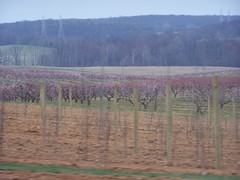 Somewhere on Darnestown Road, Agricultural Preserve, Montgomery County, Maryland. (Photos shot from the window of a speeding car...)
Somewhere on Darnestown Road, Agricultural Preserve, Montgomery County, Maryland. (Photos shot from the window of a speeding car...)It took a speech by Henry Glassie, author of Vernacular Architecture and other great books on the American cultural landscape, for me to really understand the link between compact development and center city revitalization and the preservation of rural and/or less developed agricultural and other lands.
Since I don't have a car, I lead a pretty DC-insular life when it comes to the Washington region, and I have never really been to upper Montgomery County (other than a field trip once with a friend to see what the "New Urbanist" community of Kentlands really looked like--our verdict, compared to rowhouse neighborhoods in DC's center, was "not much").
So last night's trip to a wedding reception in a barn was eye-opening. Upper Montgomery County, because of their zoned creation of an "Agricultural Preserve," retains its rural character. It really is a different experience, and certainly makes me appreciate what are similar issues in the outer "suburbs" of Northern Virginia such as in Western Loudoun County, which has a similar landscape character compared to Upper Montgomery.
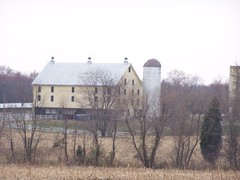
For some reason, the website for Rural Montgomery is inoperative, although it was last summer, when I wrote a little about the 25th anniversary of the Agriculture Preserve (without having seen it) in the context of farming and farmers markets. This article from the Audubon Society explains how the preserve works, "Montgomery County’s Ag Reserve Celebrates its 25th Anniversary!" And the Montgomery Countryside Alliance is another organization dedicated to preserving the preserve...
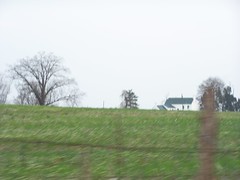
From the MCA website, this list of benefits derived from the Agricultural Preserve:
- More than 90,000 acres of farmland comprise an aesthetic and historic rural landscape within an hour's drive of suburban Montgomery County and metropolitan Washington, D.C. Residents of more densely populated areas can "recharge" by visiting this beautiful countryside. (Note that 90,000 acres is twice the size of the City of Washington).
- The Agricultural Reserve provides fresh produce to area residents at pick-your-own farms, orchards, and farm stands within the Reserve, and at farmers markets, grocery stores and restaurants in nearby cities and suburbs.
- The pastoral acreage of the "Ag Reserve" serves as a "green lung" for the Washington, D.C. area, cooling and cleaning the air. The Ag Reserve also protects our groundwater and stream and river watersheds.
- Farming in the County employs 10,000 people and contributes $252 million to the annual economy. Working farms contribute more to the economy than the costs of services they require. By preserving farmland, the County saves millions of dollars and can use these limited resources to improve existing communities.
- The Ag Reserve offers a wealth of recreational opportunities, including horseback riding, cycling, hiking, canoeing, kayaking, fishing and hunting in addition providing critical habitat for wildlife.
- The Ag Reserve preserves historic Civil War sites, routes of the Underground Railroad and 18th and 19th century homes, barns, mills and schools. Many artists, artisans and writers draw inspiration and resources from the Reserve and, each year, thousands of school children visit the Reserve to learn about their agricultural heritage.
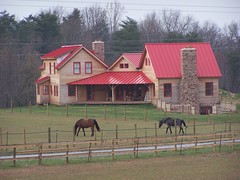 Horses in Dickerson, Agricultural Preserve, Montgomery County, Maryland. (Site of the wedding reception.)
Horses in Dickerson, Agricultural Preserve, Montgomery County, Maryland. (Site of the wedding reception.)
And these threats to the maintenance of the rural character and landscape of Upper Montgomery County:
- The Techway - This proposed bridge over the Potomac River represents a $1 billion expenditure which would not only aggravate the traffic problem it is purported to fix, but would also spread development into semi-rural and rural areas in Virginia and Maryland.
- Sand Mounds - Sand mounds are alternatives to a traditional septic system and have been used to facilitate the development of previously pristine areas of the Agricultural Reserve.
- Private Institutional Facilities (PIFs) - The scale of these proposed facilities dramatically contrasts to the rural character of the Agricultural Reserve. If built, these institutions threaten to take acres of land out of agricultural production, increase traffic and degrade our watersheds with polluted run-off from large parking lots.
- Child Lots - Originally created to allow children of farmers to build homes and to live on family property, the child lot provision has been abused so that additional houses are built and then sold on the open market.
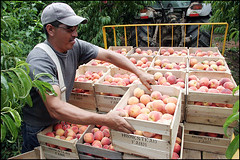 How to tell when a "farmer" at a farmers market is the real thing. They use wooden crates. Washington Post photo by James Thresher.
How to tell when a "farmer" at a farmers market is the real thing. They use wooden crates. Washington Post photo by James Thresher.
The Post photo accompanied this still online Post article about the Ag Preserve, "A Not-So-Happy Anniversary: Pressure From Builders Mounts as Ag Reserve Reaches Its 25th Year," and this Map of the Agricultural Preserve. I mentioned these pieces in the blog entry "It's all about the Growth Machine..." from last August.
The photos illustrating the previous entry about the Washingnton Business Journal illustrate the other side of sprawl--big box retail, glass box buildings, branded hotels--sharing design features with similar buildings constructed in other suburbs throughout the U.S. , making the average metropolitan region look pretty similar to its counterparts (e.g., try to figure out the difference between suburban Detroit, suburban Houston, and suburban DC.
With the exception of certain regionally-specific retail chains (Roy Rogers around here, Taco Cabana in Houston) and some occasional regionally-specific architecture, such as the Southwest-Adobe style in Houston, which isn't actually native to that area, they all look the same.
The existence of Montgomery County's Agricultural Preserve demonstrates what in most cases we are paving and building over. And what we are losing as a result.
For photographs of Western Loudoun--Catoctin(?)--County's rural landscape, check out the blog Pastoral Landscapes of Loudoun County.
Index Keywords: sprawl; agriculture; land-preservation
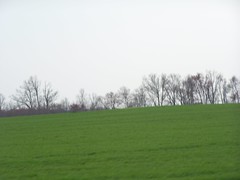
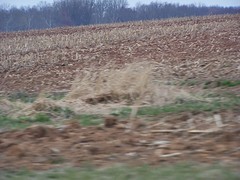



0 Comments:
Post a Comment
<< Home